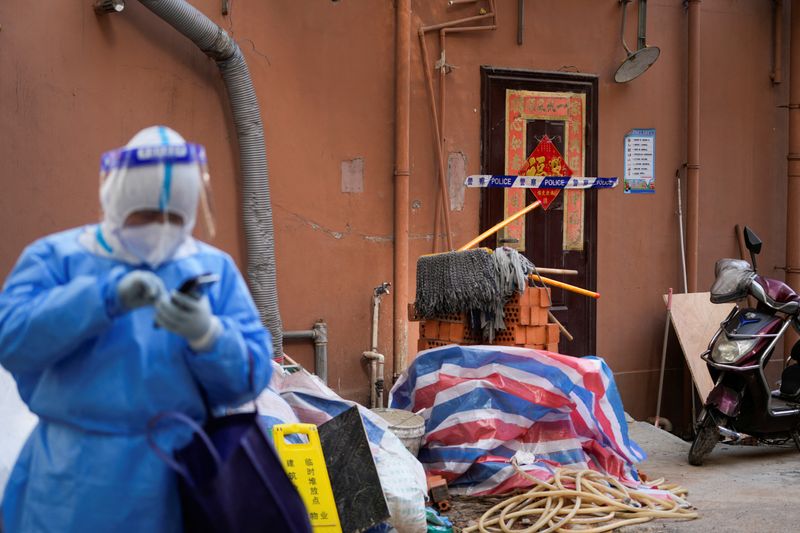
The COVID-19 outbreak in Shanghai, China's largest metropolis, remains “extremely bleak” amid ongoing confinement that confines around 26 million people in their homes, a city official said on Tuesday.
The head of the Shanghai task force on epidemic control, Gu Honghui, was quoted by state media as saying that the outbreak in the city “is still developing at a high level”.
“The situation is extremely grim,” Gu said.
China has sent more than 10,000 health workers from across the country to help the city, including 2,000 from the army, and is conducting massive tests on residents, some of whom have been locked up for weeks.
Most of eastern Shanghai, which was supposed to reopen last Friday, remained blocked along with the western half of the city.

Officials will reevaluate preventive measures after test results are analyzed to all city residents, Gu said.
“Before that, citizens are asked to continue the current closure measures and stay in their homes, except in medical and other emergencies,” Gu said.
Shanghai has reported more than 73,000 positive cases of COVID-19 since the resurgence of the highly contagious variant Omicron in March.
Shanghai recorded another 13,354 cases on Monday, the vast majority of them asymptomatic, bringing the city's total to more than 73,000 since the last wave of infections began last month. No deaths have been attributed to the outbreak driven by the omicron BA.2 variant, which is much more infectious but also less lethal than the previous delta strain.
A separate outbreak continues in the northeastern province of Jilin and the capital, Beijing, also saw nine other cases, only one of them asymptomatic. The workers closed an entire shopping center in the city where a case had been detected.

While China's vaccination rate is around 90%, its domestically produced inactivated virus vaccines are considered weaker than mRNA vaccines, such as those produced by Pfizer-BioNTech and Moderna, which are used abroad, as well as in the Chinese territories of Hong Kong and Macau. Vaccination rates among the elderly are also much lower than those of the general population, with only about half of those over 80 years of age fully vaccinated.
Meanwhile, complaints have arisen in Shanghai about difficulties in obtaining food and daily necessities, and the shortage of medical workers, volunteers and beds in isolation rooms where tens of thousands are kept under observation.
Shanghai has converted an exhibition hall and other facilities into mass isolation centers where people with mild symptoms or no symptoms are accommodated in a sea of beds separated by temporary partitions.
Gu said that there are some 47,700 beds available for COVID-19 patients, and that another 30,000 beds will soon be ready. It was not clear how many beds were available for patients under observation, which number more than 100,000 according to the city's health authorities.
Public outrage has been fueled by reports and video clips posted on the Internet documenting the death of a nurse who was denied admission to her own hospital due to COVID-19 restrictions, and the separation of young children from their parents.

The circulation of images showing several babies in cribs prompted the city's Public Health Clinical Center to issue a statement saying that the children were well cared for and were in the process of being moved to a new facility when the images were taken.
At a virtual town hall on Monday, the U.S. The US government in Shanghai warned of possible family separations amid the shutdown, but said it had an “extremely limited capacity” to intervene in such cases.
Concerns are growing about the potential economic impact on China's financial capital, also a major shipping and manufacturing hub. Most public transport was suspended and non-essential businesses closed, although airports and train stations remain open and the city's port and some major industries, such as automotive plants, continue to operate.
International events in the city have been canceled and three out of five foreign companies operating in Shanghai say they have cut sales forecasts this year, according to a survey conducted last week by the US Chamber of Commerce. One third of the 120 companies that responded to the survey said they have delayed investments.
Despite those concerns and growing public frustration, China says it sticks to its hardline “zero tolerance” approach that calls for lockdowns, mass testing, and mandatory isolation of all suspected cases and close contacts.
(with information from AP)
KEEP READING:
Últimas Noticias
Debanhi Escobar: they secured the motel where she was found lifeless in a cistern
Members of the Specialized Prosecutor's Office in Nuevo León secured the Nueva Castilla Motel as part of the investigations into the case

The oldest person in the world died at the age of 119
Kane Tanaka lived in Japan. She was born six months earlier than George Orwell, the same year that the Wright brothers first flew, and Marie Curie became the first woman to win a Nobel Prize

Macabre find in CDMX: they left a body bagged and tied in a taxi
The body was left in the back seats of the car. It was covered with black bags and tied with industrial tape
The eagles of America will face Manchester City in a duel of legends. Here are the details
The top Mexican football champion will play a match with Pep Guardiola's squad in the Lone Star Cup

Why is it good to bring dogs out to know the world when they are puppies
A so-called protection against the spread of diseases threatens the integral development of dogs




